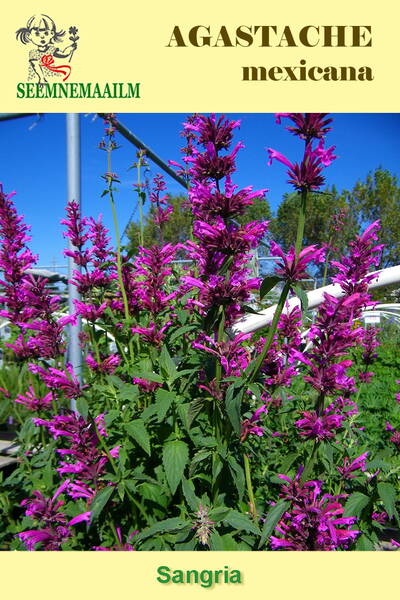A fragrant perennial plant with the aroma of licorice, forming dozens of long whorls of red-violet color. Foliage with the scent of lemon. Excellent honey plant. Culinary and tea use.
Tinctures help remove toxins, slags, and radionuclides from the body. Alcohol tincture is indicated for paralysis, paresis, regulation of metabolism, as a means of preventing vascular aging. Normalizes blood pressure. Scented pillows from dried lophanthus for restful sleep, from headaches.
Natural flowering period: July - October. Blooms in the first year.
Height of flowering plant: 120 cm.
Type of growth: erect.
Distance between plants: 60 cm.
1.0 g = 2550 seeds.
Agricultural technology.
Seeds are sown in autumn on seedling beds or in February-March for seedlings. Seeds require preliminary stratification: sow seeds to a depth of no more than 0.5 cm, moisten with a spray bottle, cover with glass and place in the refrigerator (temperature +5+7°C). Crops are kept in such conditions for 10-15 days, then transferred to room conditions. It is necessary to monitor the humidity of crops and ventilation. At a temperature of +18+20°C, shoots appear on the 10-14th day. If there is no germination, repeat the "cold-heat" method in the same sequence.
Seedlings are picked into boxes in the phase of 2-3 true leaves. Seedlings are planted in open ground after 4-6 weeks. Prefers sunny places or light partial shade with loose, non-acidic soil. Can grow in one place for 5-6 years.
* Mexican mint, in nature grows in the south of North America, in Mexico, at an altitude of 2000 m above sea level. In Mexico, this lofant is called Toronjil.
A perennial plant that does not tolerate harsh winters (climate zone: Z6-Z10).
However, the original species winters quite successfully in Estonia, self-sows and weeds. Dead specimens can be easily restored by sowing seeds.
During the summer, the bushes have time to grow properly, and in late summer and early autumn they decorate the garden.
Of course, the varieties are of decorative value. When planting this plant, it should be taken into account that it does not combine well with other inhabitants of flower beds, overshadowing them with its striking beauty.
This plant bushes strongly, forming a clump, and spreads over a large area by means of underground shoots. However, it will not fill the entire garden, as most young plants die in winter during frosts. In the spring, seeds that ripened last season and fell to the ground often sprout in place of last year's lophanthus plantings. It has a strong licorice aroma. It blooms in late summer - early autumn. The plant's winter hardiness is up to -23 °C (climate zone 6). In our area, it usually dies in winter, leaving self-seeding that sprouts in the spring. As a perennial (in the south), it is a short-lived plant and requires regular renewal. The plant grows into beautiful lush clumps due to underground stolons, but has weak competitiveness in relation to other plants.
Eng.: Mexican giant hyssop. Bot. syn.: Dracocephalum mexicanum Kunth.












